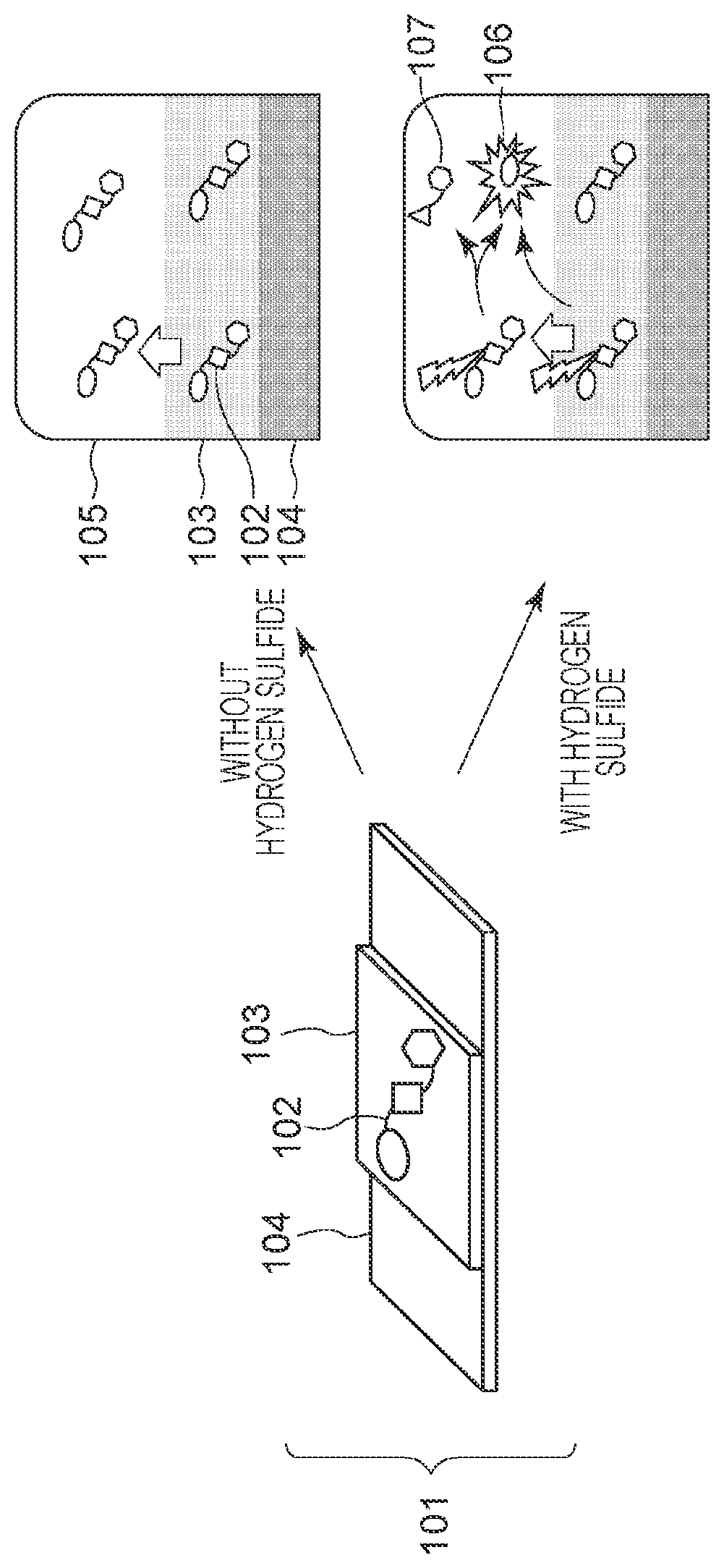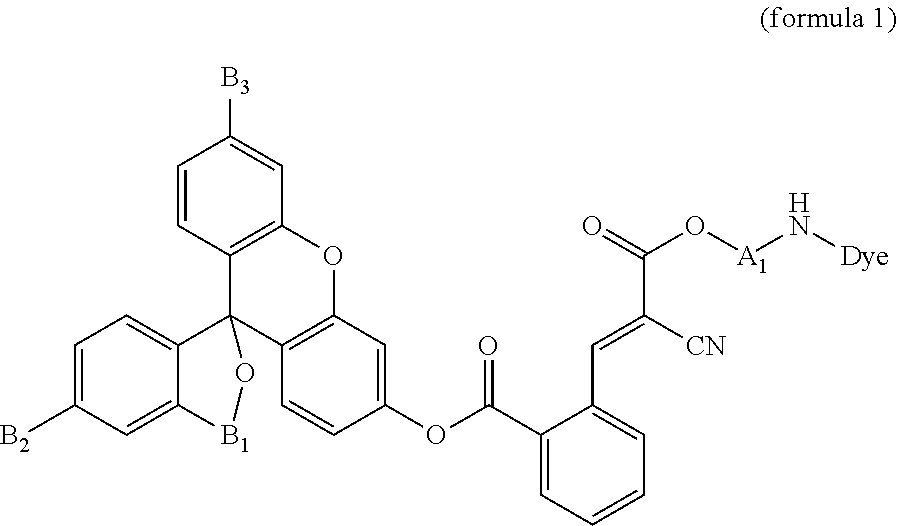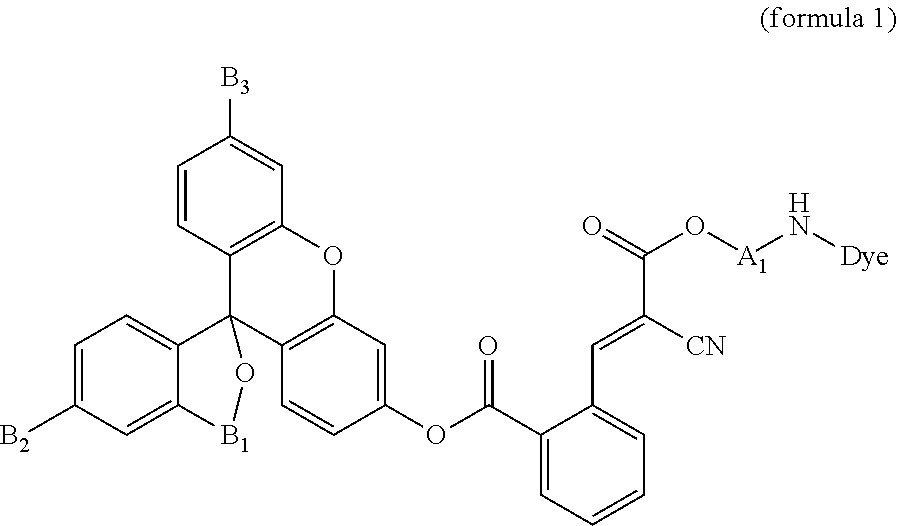Novel compound and structural body for detecting hydrogen sulfide
a technology of hydrogen sulfide and compound, which is applied in the direction of fluorescence/phosphorescence, instruments, and analysis using chemical indicators, can solve the problems of low reactivity of hydrogen sulfide, difficult detection of hydrogen sulfide with high sensitivity, and low sensitivity of hydrogen sulfide, so as to increase fluorescence intensity, increase the amount of hydrogen sulfide, and the effect of high water solubility
- Summary
- Abstract
- Description
- Claims
- Application Information
AI Technical Summary
Benefits of technology
Problems solved by technology
Method used
Image
Examples
first embodiment
Compound
[0018]A compound according to the present embodiment is represented by the formula 1:
[0019]The formula 1 is described in detail below.
Dye
[0020]Dye in the formula 1 denotes an optical absorber with optical absorption in the wavelength range of 350 to 700 nm and with a highest molecular absorption coefficient of 104 M−1 cm−1 or more. Furthermore, the Dye according to the present embodiment preferably has optical absorption in the wavelength range of 365 to 650 nm.
[0021]The Dye according to the present embodiment may be a dye, a pigment, a fluorescent material, a non-fluorescent material, a colorant, gold nanoparticles, a gold colloid, or silver nanoparticles, each having an ionic or nonionic functional group.
[0022]For example, when the Dye according to the present embodiment is a colorant, the Dye may be an azo colorant, a xanthene colorant, a coumarin colorant, a triarylmethane colorant, or ethidium bromide. The Dye according to the present embodiment can be at least a member...
second embodiment
Structural Body
[0037]A structural body according to the present embodiment includes a base material and the compound according to the first embodiment located on the base material.
Base Material
[0038]In the present embodiment, the base material may be a solid material and can have low reactivity with hydrogen sulfide. The base material in the present embodiment can be glass, ceramic, a silicon resin, paper made of cellulose or μ-fiber, felt, knit fabric, non-woven fabric, a porous material, or filter paper and can be a paper material in terms of availability.
[0039]The base material in the present embodiment may also be a glass on which a flow path or a circle is etched or a paper material on which a flow path or a circular frame is printed with a hydrophobic material. The hydrophobic material in the present embodiment may be, but is not limited to, at least one material selected from the group consisting of waxes, crayons, paraffin, SU-8, silicon, oil-based markers, poly(acrylic acid...
third embodiment
Detection Device
[0046]A detection device according to a third embodiment of the present disclosure includes a blood cell separation membrane on the base material of the structural body according to the second embodiment. The blood cell separation membrane enables the detection of hydrogen sulfide in the blood. Furthermore, as in the second embodiment, homocysteine α,γ-lyase on the base material can detect homocysteine in the blood.
PUM
| Property | Measurement | Unit |
|---|---|---|
| wavelength range | aaaaa | aaaaa |
| wavelength range | aaaaa | aaaaa |
| wavelength range | aaaaa | aaaaa |
Abstract
Description
Claims
Application Information
 Login to View More
Login to View More - R&D
- Intellectual Property
- Life Sciences
- Materials
- Tech Scout
- Unparalleled Data Quality
- Higher Quality Content
- 60% Fewer Hallucinations
Browse by: Latest US Patents, China's latest patents, Technical Efficacy Thesaurus, Application Domain, Technology Topic, Popular Technical Reports.
© 2025 PatSnap. All rights reserved.Legal|Privacy policy|Modern Slavery Act Transparency Statement|Sitemap|About US| Contact US: help@patsnap.com



